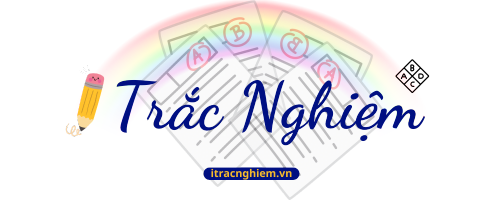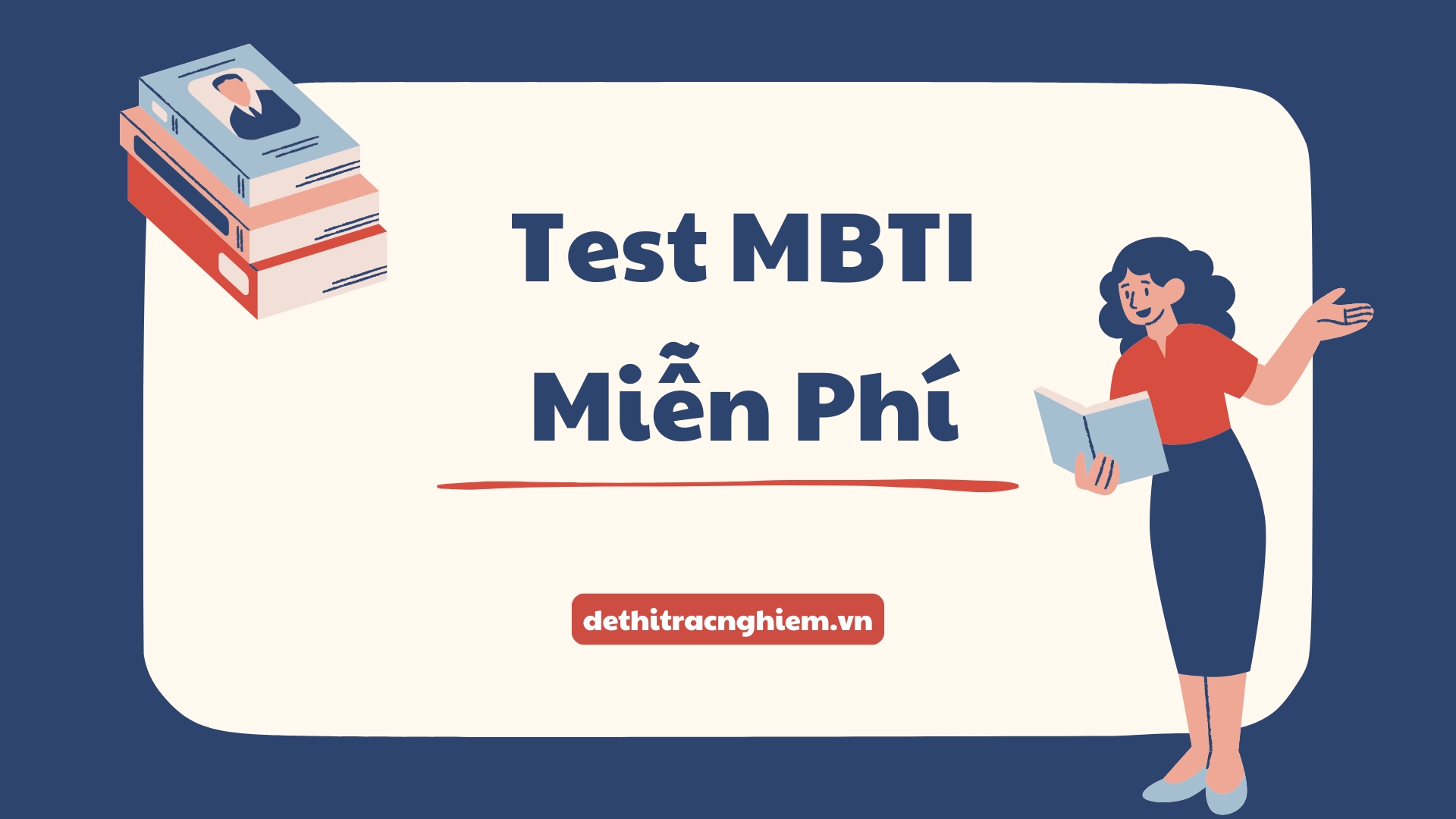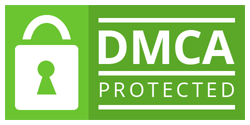Đề thi thử Đại học 2025 môn Tiếng Anh – Nguyễn Trãi – Thường Tín (Hà Nội) là một trong những đề tiêu biểu thuộc Tổng hợp đề thi thử môn Tiếng Anh THPT QG, nằm trong chương trình Đề thi vào Đại học. Được biên soạn bởi Trường THPT Nguyễn Trãi – Thường Tín (Hà Nội), đề thi này hướng đến việc giúp học sinh lớp 12 nâng cao kỹ năng làm bài thi trắc nghiệm theo đúng chuẩn của kỳ thi Tốt nghiệp THPT Quốc gia năm 2025.
Với cấu trúc đề được xây dựng sát với đề minh họa của Bộ GD&ĐT, đề thi bao gồm các phần quen thuộc: phát âm – trọng âm, ngữ pháp – từ vựng, chức năng giao tiếp, tìm lỗi sai, viết lại câu, và đọc hiểu. Đề có sự phân bố hợp lý giữa các mức độ nhận biết, thông hiểu và vận dụng, giúp học sinh đánh giá đúng trình độ hiện tại và rèn luyện kỹ năng làm bài dưới áp lực thời gian thực tế.
Hãy cùng Dethitracnghiem.vn khám phá ngay đề thi thử từ Trường THPT Nguyễn Trãi – Thường Tín (Hà Nội) và bắt đầu ôn luyện để tự tin bước vào kỳ thi Tốt nghiệp THPT năm 2025!
- Số trang: 4 trang
- Hình thức: Trắc nghiệm
- Thời gian làm bài: 50 phút (không kể thời gian phát đề)
ĐỀ THI THỬ ĐẠI HỌC MÔN TIẾNG ANH NĂM 2025 NGUYỄN TRÃI – THƯỜNG TÍN (HÀ NỘI)
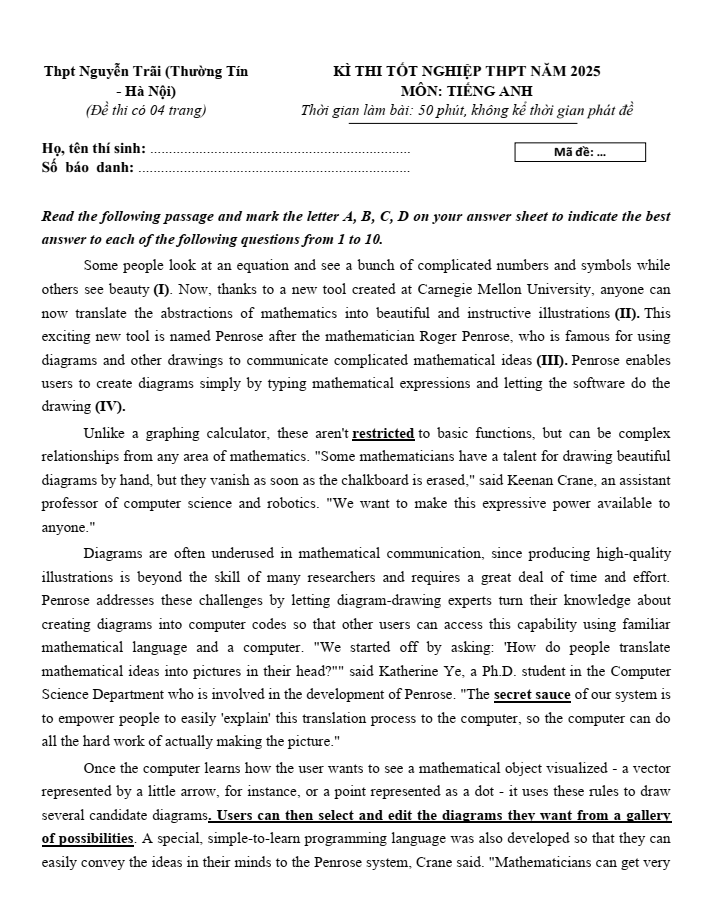
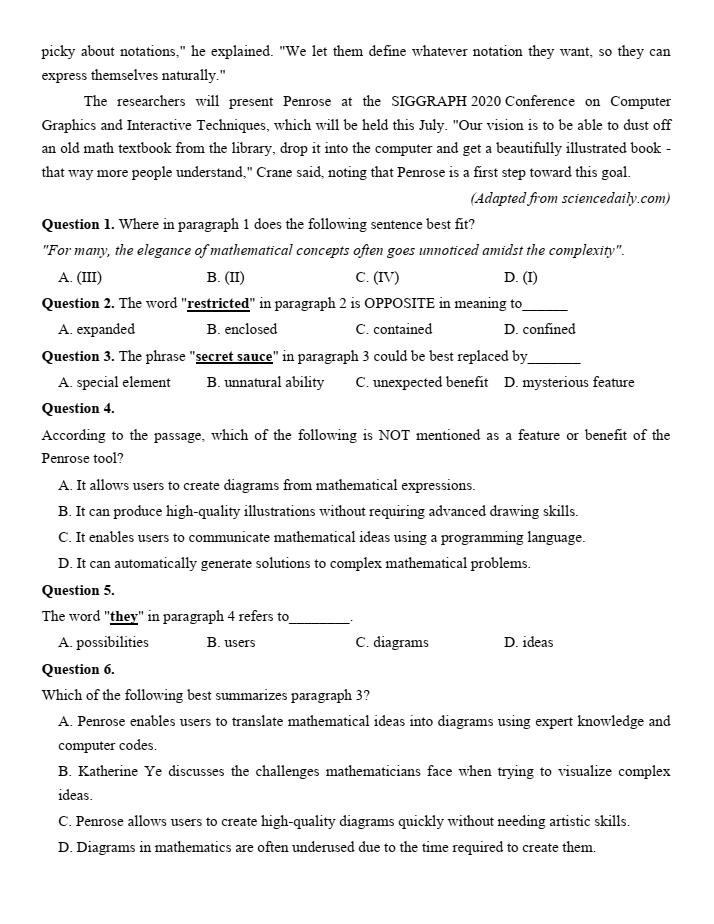
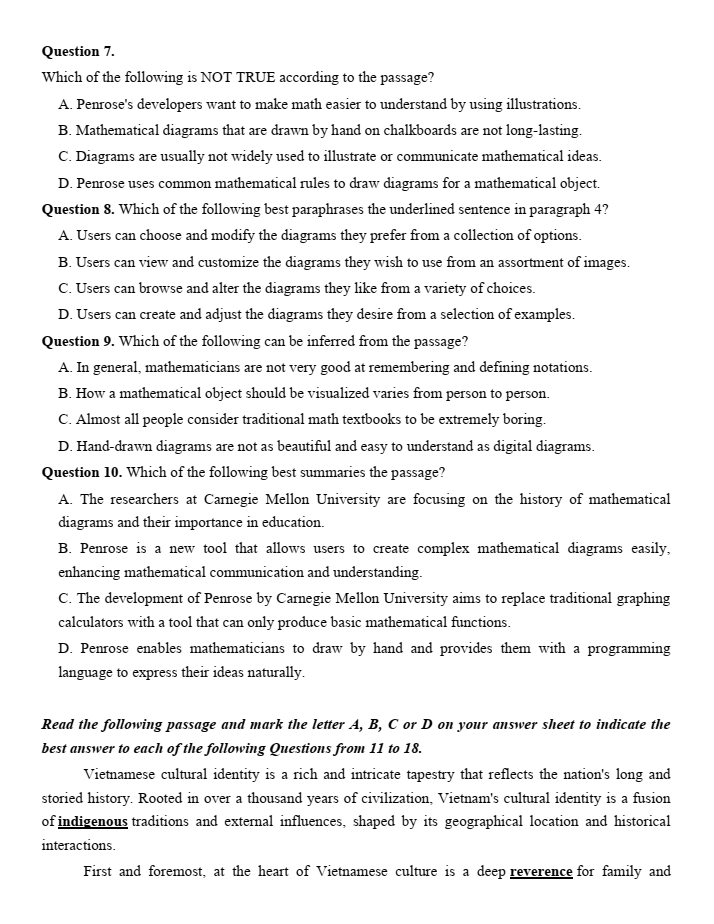
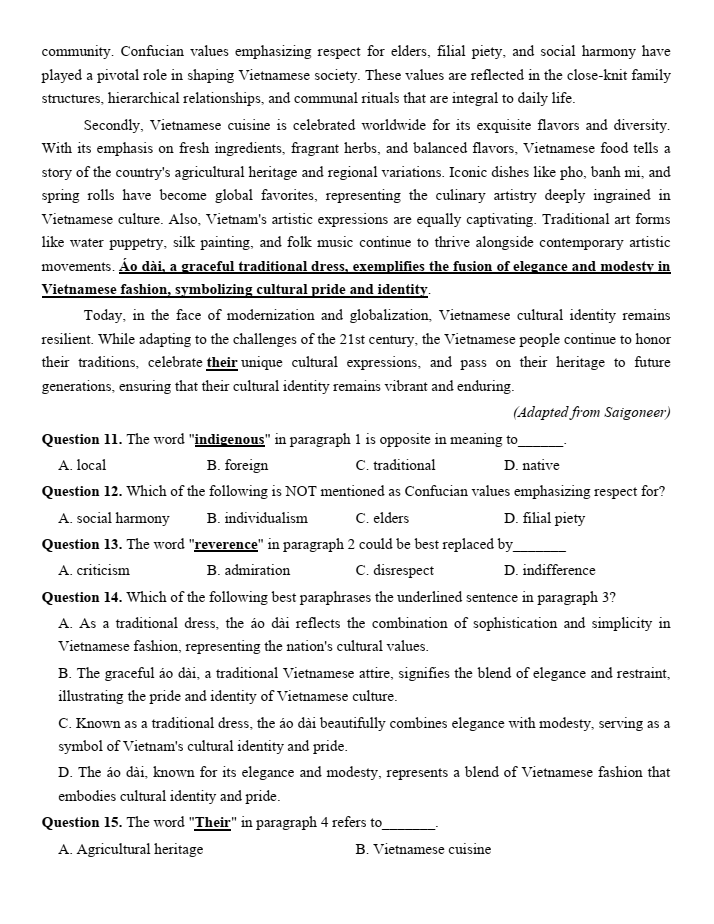
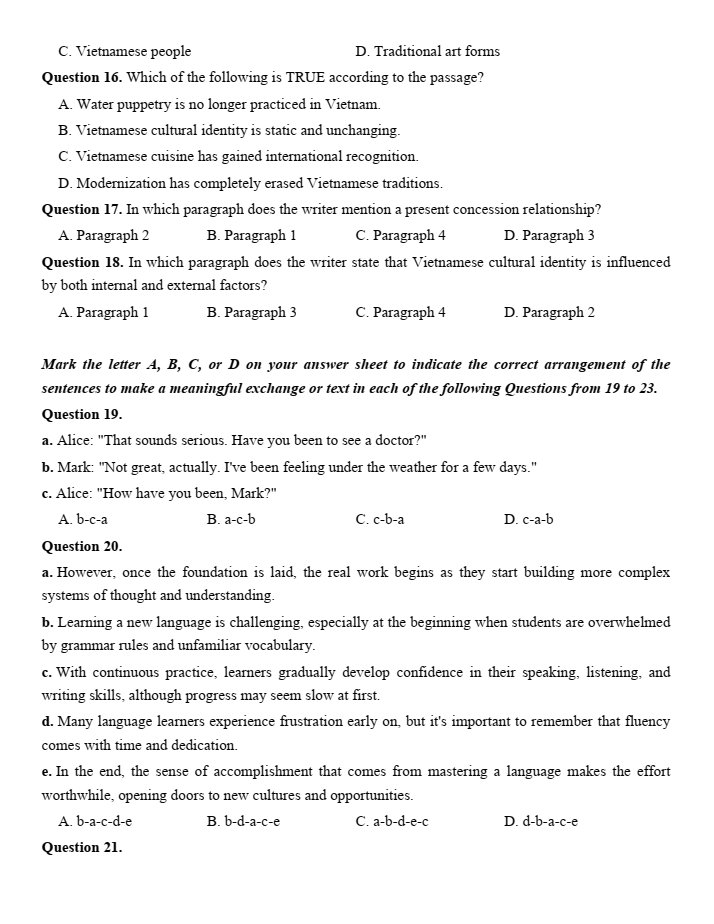
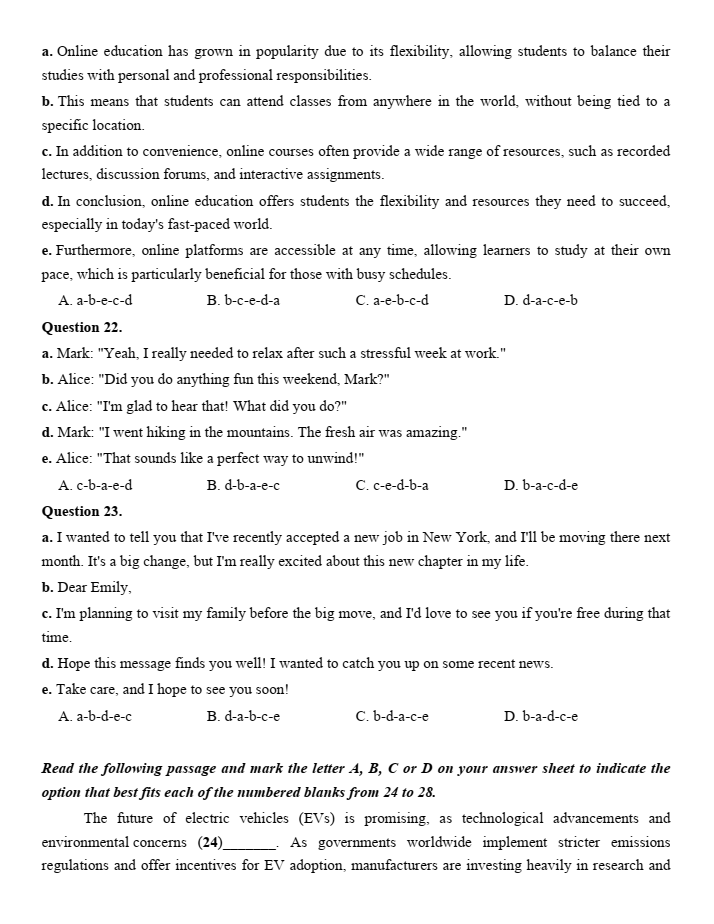
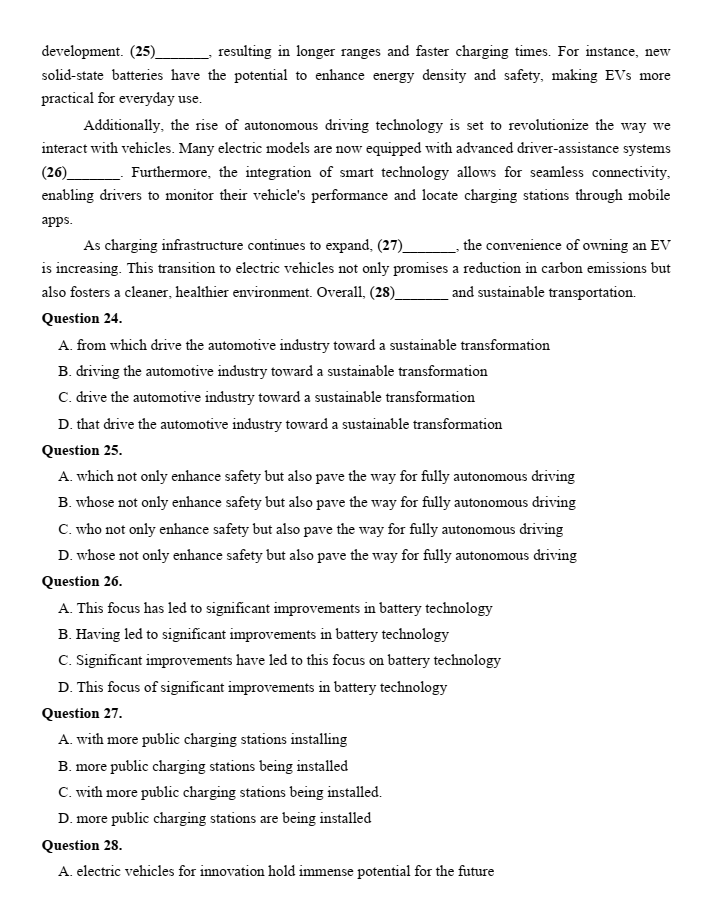
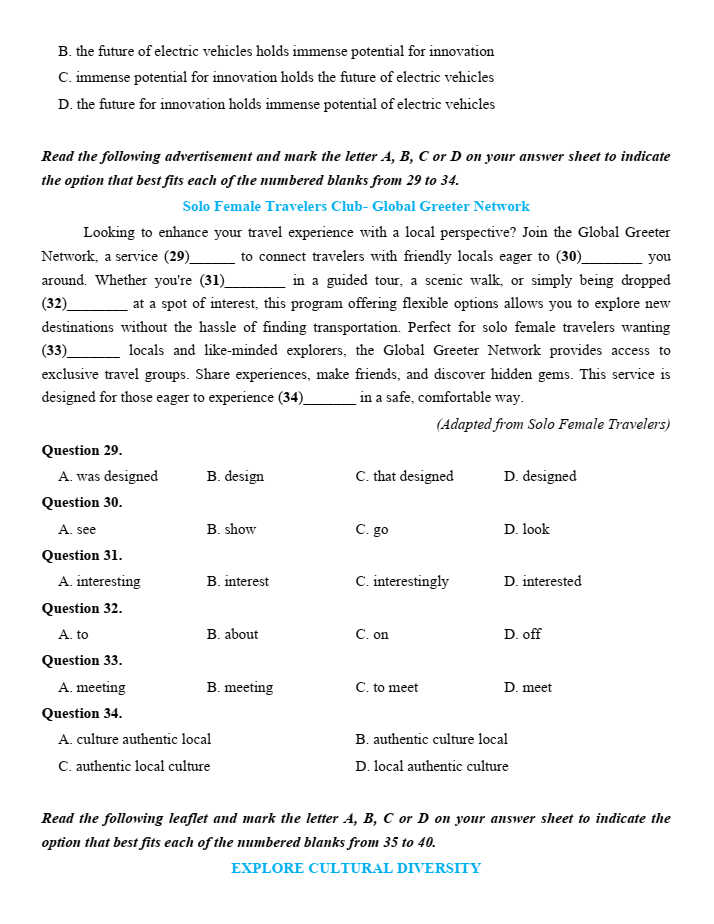
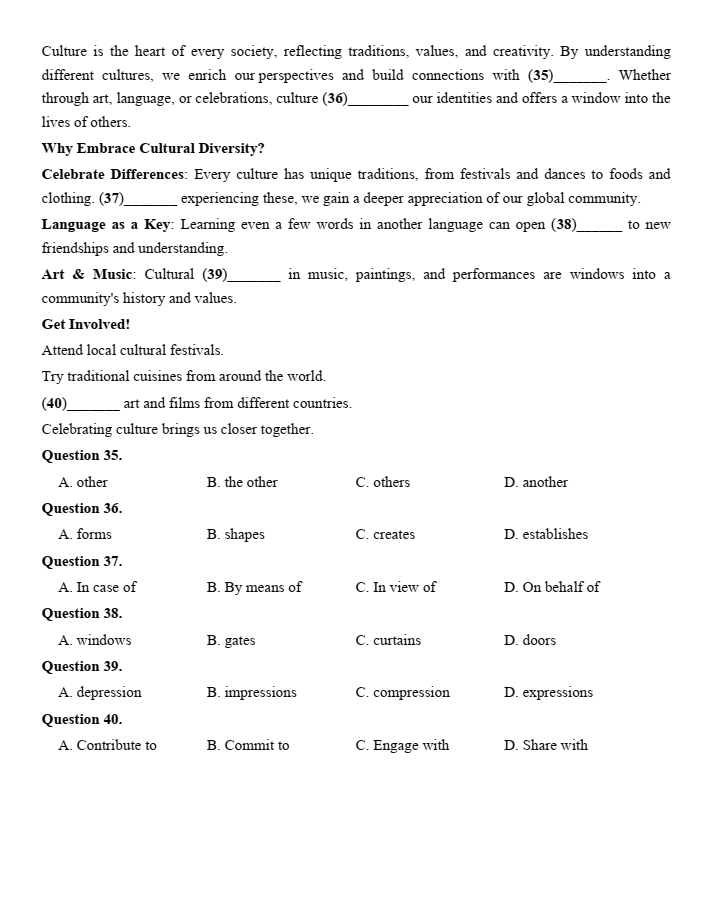
Mark the letter A, B, C, or D on your answer sheet to indicate the best arrangement of utterances or sentences to make a meaningful exchange or text in each of the following questions from 1 to 5.
Question 1: Dear Sir or Madam,
a. My wife and I are very grateful for his kindness. Please convey our thanks to him. We truly appreciate your company for having such a dedicated employee.
b. I am writing to sincerely thank Mr. Baker, the cashier of your company. I hope your company will reward Mr. Baker for his noble deed.
d. Every day, I take bus Route 133 to work. Last Friday, as I was about to get off, I suddenly felt dizzy and lost consciousness. When I woke up, I was in St. Mary’s Hospital with my wife.
e. The doctor told me that Mr. Baker had sent me to the hospital and informed my wife. Though we have never met, he was on the same bus.
Yours faithfully,
(Adapted from Basic IELTS writing)
A. a-b-d-e
B. b-d-e-a
C. d-b-e-a
D. b-d-a-e
Question 2: a. Cross-cultural learning has three main benefits.
b. Secondly, it allows us to learn new ways of thinking and problem-solving by exchanging ideas with others.
c. Finally, it encourages us to appreciate diversity and work together with people from various cultures.
d. Firstly, it helps us understand and respect different backgrounds, making us more open-minded.
e. So it is important to learn about different cultures around the world.
(Adapted from hoclieu.vn)
A. a-e-b-d-c
B. a-d-b-c-e
C. e-d-b-c-a
D. a-d-b-c-e
Question 3: a. Additionally, local food festivals celebrate culinary diversity, offering a chance to taste various dishes while enjoying music and community.
b. Culinary culture connects people and reflects the identity of nations. Each dish tells a story about its history and traditions, offering a delicious way to explore different lifestyles.
c. In summary, exploring culinary cultures enriches our understanding of the world. Each experience, from tasting to cooking, helps create lasting memories and connections with different traditions.
d. Cooking classes provide a hands-on way to learn about these cultures, allowing participants to understand the origins of ingredients and the techniques used.
e. For instance, Italian pasta and Japanese sushi showcase the unique ingredients and flavors shaped by their environments.
(Adapted from hoclieu.vn)
A. a-b-d-c-e
B. b-e-a-d-c
C. e-c-b-a-d
D. c-a-b-d-e
Question 4: a. Linda: Not recently, but I’m really interested in the upcoming Mid-Autumn Festival and the lantern parade.
b. Nam: Me too! I love the mooncakes and the lantern parade.
c. Nam: Hi Linda! Have you been to any cultural festivals lately?
(Adapted from i-Learn Smart World)
A. c-a-b
B. a-b-c
C. c-b-a
D. b-c-a
Question 5: a. Lan: Come in, Mark. Did you find my place easily?
b. Lan: He goes to bed right after he comes home in the morning when there’s no one at home.
c. Mark: Yes, I actually met your dad in the street and he showed me the way.
d. Mark: Working night shifts must be really hard. When does he sleep?
e. Lan: That’s right. My dad is a factory worker, so he works in shifts. Today he’s on the night shift.
(Adapted from Global Success)
A. c-a-b-d
B. a-c-b-d-e
C. e-c-b-a-d
D. a-c-d-e-b
Read the following passage about Being a Responsible Digital Citizen and mark the letter A, B, C or D on your answer sheet to indicate the correct answer to each of the following questions from 6 to 13.
These days, digital technology is a major part of everyday life for all of us, and we use it for almost everything, from work to school and entertainment. With everyone spending so much time connected to the Internet and using digital devices, it’s important that we all understand how to be responsible digital citizens in the modern world. But what exactly does that mean?
A responsible digital citizen is someone who uses technology in a sensible way and encourages others to do the same. They are careful about their online behavior and always try to be polite in online interactions. Responsible digital citizens respect other people’s privacy, too. They don’t post pictures of others or discuss people’s private lives without their permission because that could harm their online security.
Responsible digital citizens are also aware of the potential risks of being online. They understand that there are fake websites and online scams which try to access people’s personal information to trick them into handing over their personal info and even bank accounts. When a digital citizen encounters one of these online scams, they should report it to the cyber police. By doing this, digital citizens play an important role in making the Internet a safer place for all users.
While many of us don’t know how to use digital technology safely these days, we should remember that there are many other people who are still at risk. By being responsible digital citizens, we can help everyone gain the benefits of the digital world without putting themselves at risk.
(Adapted from Bright)
Question 6: Which of the following best paraphrases the underlined sentence in paragraph 1?
These days, digital technology is a major part of everyday life for all of us, and we use it for almost everything, from work to school and entertainment.
A. These days, people mainly depend on digital technology for studying and working, not much for fun.
B. Digital technology is widely used in various aspects of modern life, including work, education, and leisure.
C. Nowadays, digital technology is used mostly for career and educational purposes rather than entertainment.
D. The role of digital technology in daily life is not very significant, and people do not rely on often.
Question 7: The word “their” in paragraph 2 refers to______.
A. experiences
B. lives
C. pictures
D. other people
Question 8: Which paragraph does the writer mention a present causal relationship of digital behavior?
A. Paragraph 2
B. Paragraph 3
C. Paragraph 1
D. Paragraph 4
Question 9: According to the passage, which of the following is NOT a characteristic of a responsible digital citizen?
A. They avoid using social media to protect themselves.
B. They try to be polite in online interactions.
C. They always respect other people’s privacy.
D. They are careful about their online behavior.
Question 10: The word “encounters” in paragraph 3 is CLOSEST in meaning to______.
A. projects
B. avoids
C. faces
D. reports
Question 11: In which paragraph does the writer discuss the risks of being online?
A. Paragraph 1
B. Paragraph 2
C. Paragraph 3
D. Paragraph 4
Question 12: Which of the following is TRUE according to the passage?
A. Digital citizens must possess advanced technical knowledge to be responsible.
B. Fake websites and scams do not pose serious threats to personal information.
C. Responsible digital citizens should report online scams to the cyber police.
D. Using digital technology today is fully aware of online risks.
Question 13: The word “sensible” in paragraph 2 is OPPOSITE in meaning to______.
A. thoughtful
B. intelligent
C. reasonable
D. unwise
Read the following passage about fitness trends and mark the letter A, B, C or D on your answer sheet to indicate the best answer to each of the following questions from 14 to 18.
Reformer Pilates is an advanced and more intense variation of traditional Pilates. While this type of equipment isn’t something you would typically have at home, you’ll need to visit a specialized Pilates center to try it! While it might look easy at first, don’t be fooled by the end of the session, your thighs will be burning, and you might struggle to walk up or down stairs for a few days afterwards. This workout pushes your body to its limits, providing a more challenging experience than standard Pilates, and many find it an effective way to build both strength and flexibility.
Trampolining is another popular fitness trend, and although it may seem like child’s play, it’s actually a highly effective workout. Jumping up and down on a trampoline can leave you feeling exhausted after just a few minutes. Surprisingly, it’s even better for heart health than jogging, while also improving coordination and helping to reduce stress levels. Trampolining is gaining widespread popularity, with new centers popping up that feature as many as 150 trampolines. These facilities offer options for everyone; you can enjoy ‘freejumping’, where you bounce without an instructor, or pay for professional lessons to learn the best techniques and get the most out of your workout.
If you’re someone who is typically active but feeling down or emotionally drained, Dynamic Running Therapy might be just what the doctor ordered. This trend involves running with a therapist, combining the benefits of physical exercise with talk therapy. Though these sessions are often more expensive than typical therapy sessions because of the professional fees, they offer significant advantages. Running while talking helps distract you from any discomfort, allowing you to cover longer distances and creates a relaxed, open environment that can make it easier to talk compared to the usual therapist’s office setting.
(Adapted from Friends Global)
Question 14: Which of the following is TRUE according to the passage?
A. Dynamic Running Therapy focuses solely on physical exercise without addressing emotional aspects.
B. Engaging in trampolining can lead to significant fatigue after only a few minutes of activity.
C. Reformer Pilates is primarily designed for beginners and requires no specialized equipment.
D. Trampolining has been shown to have minimal benefits for coordination and cardiovascular health.
Question 15: Which of the following best summarizes the passage?
A. Various fitness programs, including trampolining and Reformer Pilates, provide effective workout options, though their suitability depends on individual fitness levels and goals.
B. The passage introduces three fitness trends but highlights the drawbacks of each, showing that none provide a balanced approach to both physical and mental health.
C. Modern fitness trends cater to diverse needs by integrating fun, therapy, and structured workouts, making exercise more accessible and engaging for different individuals.
D. While Dynamic Running Therapy emphasizes emotional support, other trends like trampolining and Reformer Pilates focus primarily on physical endurance and coordination.
Question 16: According to paragraph 2, which of the following is NOT a benefit of Trampolining?
A. Reducing stress levels
B. Enhancing heart health
C. Building muscle strength
D. Improving coordination
Question 17: The word popping up in paragraph 2 is OPPOSITE in meaning to ______.
A. falling down
B. showing up
C. closing down
D. springing up
Question 18: The word they in paragraph 3 refers to ______.
A. Dynamic Running Therapy sessions
B. typical therapy sessions
C. professional fees
D. longer distances
Read the following passage about AI innovations and mark the letter A, B, C or D on your answer sheet to indicate the best answer to each of the following questions from 19 to 28.
AI innovations are becoming an integral part of healthcare, assisting in areas such as cancer screenings, medical transcription and virtual nursing. [I] Companies developing these AI-driven tools claim they enhance efficiency and reduce the workload of medical professionals. [II] However, some experts raise concerns about whether these tools perform as effectively as claimed. [III] A major issue is that many AI evaluations rely on standardized exams, such as the MCAT, rather than real-world clinical scenarios. [IV] Notably, large language models (LLMs) are trained using extensive datasets, but their evaluations are often inadequate. A review of AI assessments in healthcare found that only a small fraction involved real patient data. Most studies focused on testing medical knowledge rather than practical applications like prescription writing or patient communication. As a result, these benchmarks fail to accurately measure AI’s effectiveness in real clinical settings. Researchers argue that such limited evaluations create an unrealistic perception of AI’s capabilities, leading to premature deployment in healthcare environments.
Computer scientist Deborah Raji and her colleagues emphasize the need for more realistic and diverse evaluation methods. Current benchmarks are rigid and do not reflect the complexity of real-world medical tasks. Since they primarily assess physician-level knowledge, they overlook the perspectives of nurses and other healthcare workers. Raji suggests developing assessments based on actual clinical workflows and patient interactions, rather than relying on standardized exams that do not represent real-world applications.
To improve AI evaluation, researchers propose strategies such as gathering data from hospitals, analyzing real-world AI usage, and conducting adversarial testing to explore potential weaknesses. Transparency from hospitals and AI vendors regarding their evaluation processes and AI integration would also help create more accurate benchmarks. By focusing on real-world deployment scenarios, researchers can better assess AI’s strengths and limitations, ultimately ensuring safer and more effective applications in healthcare.
Question 19: The word “they” in paragraph 1 refers to ______.
A. health areas
B. AI-driven tools
C. companies
D. professionals
Question 20: Where in paragraph 1 does the following sentence best fit?
“A major issue is that many AI evaluations rely on standardized exams, such as the MCAT, rather than real-world clinical scenarios.”
A. [II]
B. [III]
C. [IV]
D. [I]
Question 21: The word “inadequate” in paragraph 2 is OPPOSITE in meaning to ______.
A. adequate
B. complex
C. restricted
D. sufficient
Question 22: According to paragraph 2, what is one major limitation of AI evaluations in healthcare?
A. They primarily assess theoretical knowledge instead of real-world applications.
B. They rely heavily on real patient data rather than simulated scenarios.
C. They consistently demonstrate AI’s technical errors in clinical settings.
D. They focus too much on patient communication and not enough on medical knowledge.
Question 23: Which of the following best paraphrases the underlined sentence in paragraph 2? Researchers argue that such limited evaluations create an unrealistic perception of AI’s capabilities, leading to premature deployment in healthcare environments.
A. Early adoption of AI in healthcare may result in exaggerated claims about its effectiveness.
B. Researchers believe AI lacks the capability to replace human decision-making in healthcare.
C. AI has already become widely accepted and applied in healthcare since the early age without concerns.
D. Limited evaluations may cause overestimation of AI, leading to premature use in healthcare.
Question 24: The word “overlook” in paragraph 3 is CLOSEST in meaning to ______.
A. recognize
B. highlight
C. ignore
D. examine
Question 25: Which of the following best summarizes paragraph 3?
A. Deborah Raji and her team claim that the current evaluation methods in medicine are effective and diverse but need minor adjustments to include more healthcare professionals.
B. Deborah Raji and her team argue that medical assessments should be based on real clinical workflows rather than rigid benchmarks that focus only on physician-level knowledge.
C. Deborah Raji and her team explain that the primary issue with current benchmarks is their difficulty level, which prevents many healthcare workers from performing well.
D. Deborah Raji and her team concur that standardized exams are the best way to evaluate medical knowledge, but they should be expanded to include nurses and other healthcare workers.
Question 26: Why do researchers emphasize transparency from hospitals and AI vendors?
A. To establish more reliable standards for evaluating AI.
B. To minimize the financial burden of AI implementation in hospitals.
C. To make further testing of AI in health care services unnecessary.
D. To speed up the adoption of AI across healthcare facilities.
A. To establish more reliable standards for evaluating AI.
Question 27: Which of the following can be inferred about the writer’s attitude towards using AI tools in healthcare?
A. The writer is completely opposed to AI in healthcare, believing that it poses significant risks to patients’ lives due to its lack of credibility.
B. The writer is doubtful about AI tools, so they shouldn’t be fully integrated into medical practice as the medical companies have recommended.
C. The writer sees AI as a tool for healthcare but stresses the need for rigorous, real-world evaluation before widespread adoption.
D. The writer is optimistic about AI’s potential but stresses the need for more rigorous evaluation before widespread adoption.
Question 28: Which of the following best summarizes the passage?
A. AI is revolutionizing healthcare, and although existing evaluation methods are limited, its safety and effectiveness are unquestionable, leaving no need for further evaluation.
B. AI tools in healthcare are unreliable and should not be used in clinical settings due to the limitations of current evaluation methods.
C. While AI tools offer potential benefits in healthcare, current evaluation methods are inadequate, leading to concerns about their real-world effectiveness and premature deployment.
D. The primary challenge in AI adoption in healthcare is getting hospitals and vendors to be more transparent about their data and evaluation processes.
Read the following advertisement and mark the letter A, B, C or D on your answer sheet to indicate the option that best fits each of the numbered blanks from 29 to 34.
Solo Female Travelers Club – Global Greeter Network
Looking to enhance your travel experience with a local perspective? Join the Global Greeter Network, a service (29) ____ to connect travelers with friendly locals eager to (30) ____ you around. Whether you’re (31) ____ in a guided tour, a scenic walk, or simply being dropped (32) ____ at a spot of interest, this program offering flexible options allows you to explore new destinations without the hassle of finding transportation. Perfect for solo female travelers wanting (33) ____ locals and like-minded explorers, the Global Greeter Network provides access to exclusive travel groups. Share experiences, make friends, and discover hidden gems. This service is designed for those eager to experience (34) ____ in a safe, comfortable way.
(Adapted from Solo Female Travelers)
Question 29:
A. was designed
B. design
C. that designed
D. designed
Question 30:
A. see
B. show
C. go
D. look
Question 31:
A. interesting
B. interest
C. interestingly
D. interested
Question 32:
A. to
B. about
C. on
D. off
Question 33:
A. meeting
B. meeting to
C. to meet
D. meet
Question 34:
A. culture authentic local
B. authentic culture local
C. authentic local culture
D. local authentic culture
Read the following leaflet and mark the letter A, B, C or D on your answer sheet to indicate the correct option that best fits each of the numbered blanks from 35 to 40.
EXPLORE CULTURAL DIVERSITY
Culture is the heart of every society, reflecting traditions, values, and creativity. By understanding different cultures, we enrich our perspectives and build connections with (35) ____. Whether through art, language, or celebrations, culture (36) ____ our identities and offers a window into the lives of others.
Why Embrace Cultural Diversity?
Celebrate Differences: By (37) ____ experiencing these, we gain a deeper appreciation of our global community.
Language as a Key: Learning even a few words in another language can open (38) ____ to new friendships and understanding.
Art & Music: Cultural (39) ____ in music, paintings, and performances are windows into a community’s history and values.
Get Involved!
Attend local cultural festivals.
Try traditional cuisines from around the world.
(40) ____ art and films from different countries.
Celebrating culture brings us closer together.
Question 35:
A. other
B. the other
C. others
D. another
Question 36:
A. forms
B. shapes
C. creates
D. establishes
Question 37:
A. In case of
B. By means of
C. In view of
D. On behalf of
Question 38:
A. windows
B. gates
C. curtains
D. doors
Question 39:
A. depression
B. impressions
C. compression
D. expressions
Question 40:
A. Contribute to
B. Commit to
C. Engage with
D. Share with
Mục đích tổ chức kỳ thi Đại học năm 2025 là gì?
Căn cứ theo quy chế hiện hành của Bộ Giáo dục và Đào tạo và các văn bản hướng dẫn tổ chức kỳ thi Đại học năm 2025, mục đích của kỳ thi là:
– Đánh giá kết quả học tập của học sinh sau 12 năm học theo yêu cầu của chương trình giáo dục phổ thông.
– Lấy kết quả thi để xét công nhận tốt nghiệp trung học phổ thông và làm căn cứ tuyển sinh đại học, cao đẳng.
– Góp phần đánh giá chất lượng giáo dục của địa phương và cả nước, làm cơ sở điều chỉnh nội dung, phương pháp dạy học trong nhà trường.
Thí sinh thi Đại học năm 2025 có bắt buộc thi môn Tiếng Anh không?
Theo quy định hiện hành của Bộ Giáo dục và Đào tạo và hướng dẫn tổ chức kỳ thi tốt nghiệp Đại học năm 2025, thí sinh dự thi phải thực hiện như sau:
– Thi 3 môn bắt buộc: Toán, Ngữ văn và Ngoại ngữ.
– Ngoài ra, thí sinh phải chọn một trong hai bài thi tổ hợp: Khoa học Tự nhiên (gồm các môn Vật lí, Hóa học, Sinh học) hoặc Khoa học Xã hội (gồm các môn Lịch sử, Địa lí, Giáo dục công dân – dành cho học sinh học chương trình giáo dục phổ thông).
Trong số các môn thi, Tiếng Anh là một trong ba môn thuộc bài thi Ngoại ngữ bắt buộc, thí sinh phải thi môn Tiếng Anh như một môn bắt buộc, không phụ thuộc vào lựa chọn bài thi tổ hợp hay mục đích xét tuyển đại học.
Như vậy, kỳ thi Đại học năm 2025 bắt buộc thí sinh phải thi môn Tiếng Anh.
